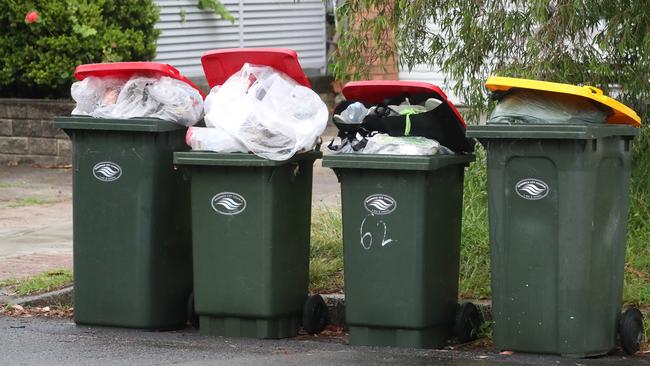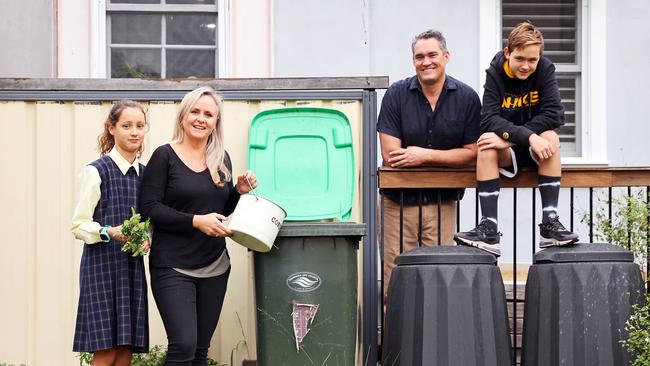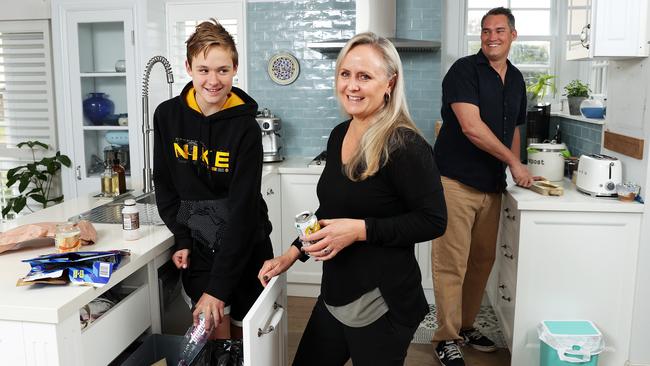New NSW rubbish bin plan aims to reduce landfill, boost recycling
Every home in NSW will be pushed to stop dumping food scraps and organic waste into their red landfill bins in a move designed to radically boost recycling rates and reduce landfill. Take our poll.
NSW
Don't miss out on the headlines from NSW. Followed categories will be added to My News.
Household garbage bins are set to be overhauled as part of a more than $350 million state government waste “revolution” designed to dramatically boost recycling rates and reduce landfill.
The plan, put forward by Energy and Environment Minister Matt Kean and to be unveiled in the upcoming NSW budget, will involve standardising bins across local government areas.
The biggest change will involve all councils providing households with a separate green bin for food and garden organics to remove perishable items like leftover meals and scraps from the red landfill bin.
A government source said the aim was to halve red bin waste with the strategy also potentially reducing household waste levies by 50 per cent. Councils will be given a 2030 deadline to introduce the changes.
A statewide education campaign will be rolled out, with consultation to occur with local government on how the changes might apply to different community groups such as high rise residents.

It will be up to councils to decide how often to collect the food and organics bins, and how to tackle the issue of smelly food scraps awaiting collection and households using plastic bags — plastic waste reduction is another aim of the “rubbish revolution” — for their food rubbish to stop stinks.
But one council’s scheme may point to solutions.
Randwick City Council began asking residents to separate food waste in March with households receiving a new 240L green lid Food Organics and Garden Organics (FOGO) bin to dispose food scraps.
Residents were given a free kitchen caddie to place in the kitchen to dispose food scraps before emptying into the green bin. Council also handed residents compostable bags to use as bin liners — although the council advised scraps could also be wrapped in old newspapers. The council is collecting the bins weekly.
It is understood the government hopes halving red bin waste could see a reduction in waste levy fees on families.
Supermarkets and restaurants are also targeted under the State government rubbish and recycling scheme and they will be forced to separate out food waste Supermarkets and select hospitality businesses will have four years to make the changes with both groups given $65 million to help pay for the transition.
The Government has set a target to reduce the total volume of trash generated by each NSW resident by 10 per cent by 20230.
With landfill for all of Greater Sydney set to reach capacity in just 15 years – and each person set to produce the equivalent weight of two cars in rubbish per year in the next 20 years – the Government has set an ambitious goal of reducing litter by 60 per cent by 2030.
The government has also committed to recover 80 per cent of rubbish from all waste streams by 2030 while working to dramatically boost industrial use of its own recycled material. With plastic also a key target, it aims to triple the recycling of plastics by 2030 and reduce plastic waste by almost one-third within the next four years.
The government will also develop a new measure for emissions performance of NSW waste and materials management so its effectiveness can be tracked across the life cycle of materials.
The strategy also reaffirms government commitment to achieving its goal of net zero emissions from organic waste by 2030. With waste volumes predicted to soar from 21 million tonnes today to 37 million by 2041, Mr Kean said it was critical action was taken.
“This is the biggest shake up of how we deal with waste in a generation,” he said.
“It’s about turning our waste into a resource, driving down costs for families, and delivering a better environment for everyone.
“This is about driving a circular economy by creating value out of our rubbish. The less we put in to landfill, the lower the lower the bills for families.”


Not only is waste filling up landfill, an estimated 575 million items of plastic littered each year in NSW was contributing to soil pollution and killing native wildlife, he said.
Waste was also contributing to the State’s carbon footprint with NSW households and businesses sending 1.2 million tonnes of food scraps, garden clippings, timber, textiles and paper in 2019 to landfill, adding around two per to NSW’s overall emissions.
Maroubra mum Lara Barclay already has four bins in her kitchen with her husband and two children already separating out food waste such as leftover meals along with plastics to take back to the supermarket for recycling.
Ms Barclay, who recently developed an app to help families identify what waste items need to go where, said her local council had already introduced a “food and organics” bin a few months ago.
“We have a cool little compost bin on our benchtop for food waste,” she said.
“People think if you separate out food, you will get maggots, but you’re going to get maggots in the red bin anyway if it’s left too long.
“We do have a freestanding house so it is a bit easier for us. About 80 per cent of our rubbish is the same stuff each week so the kids don’t really get mixed up with the rest being new products such as takeaway containers.”
The environmental consultant said she believed more items had more packaging, especially home deliveries.




